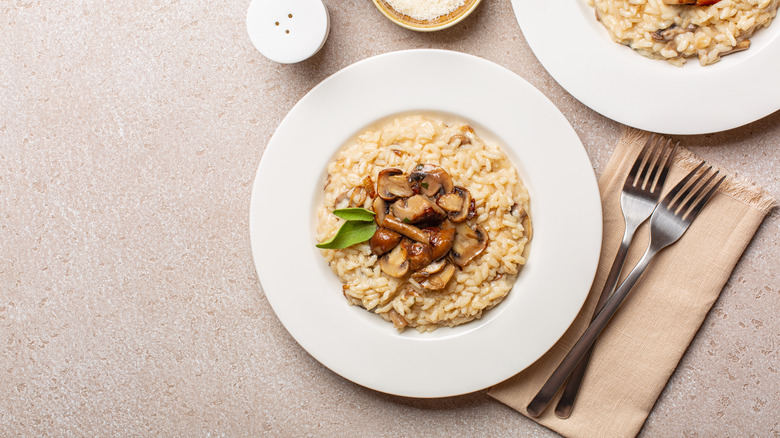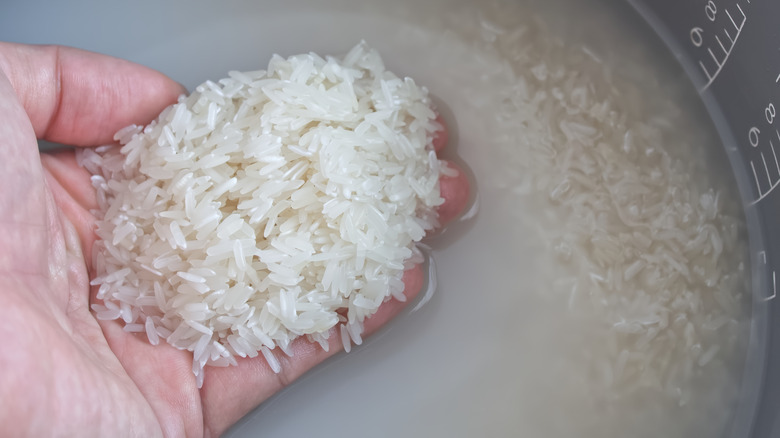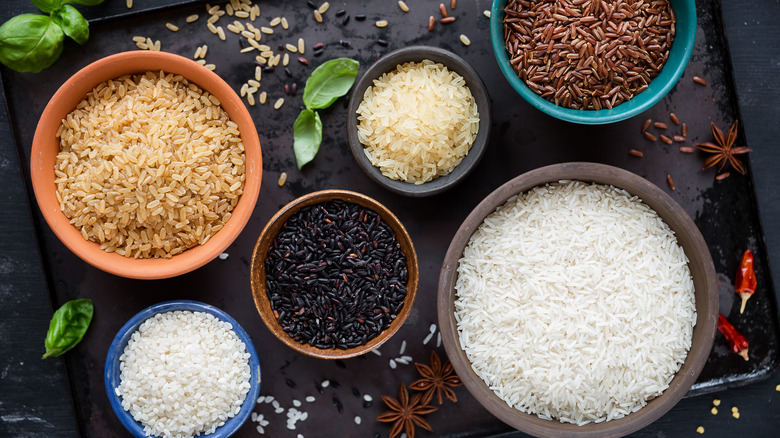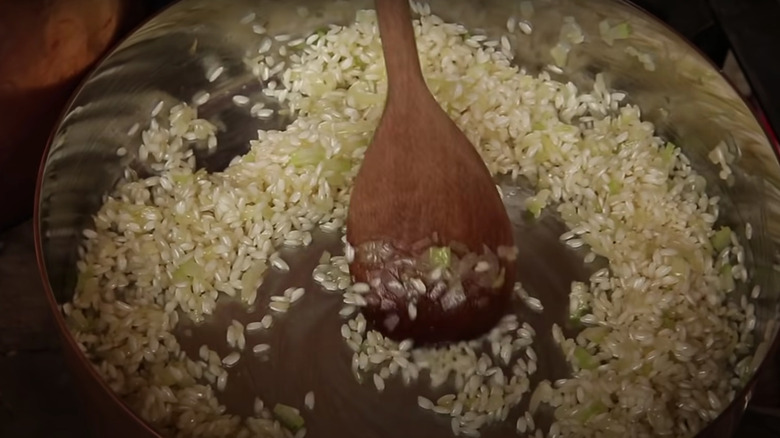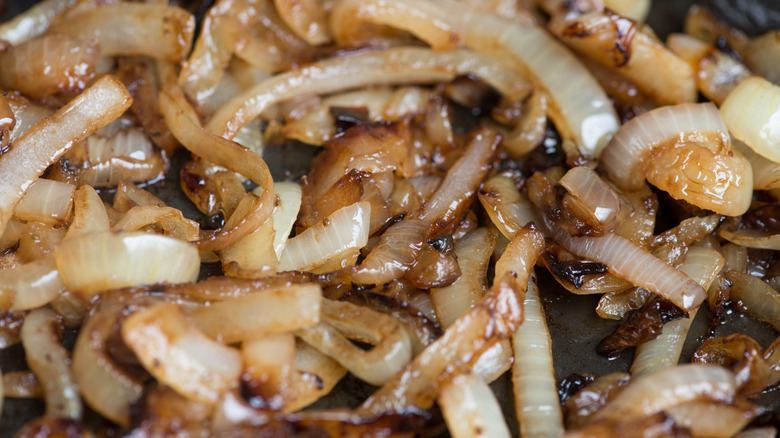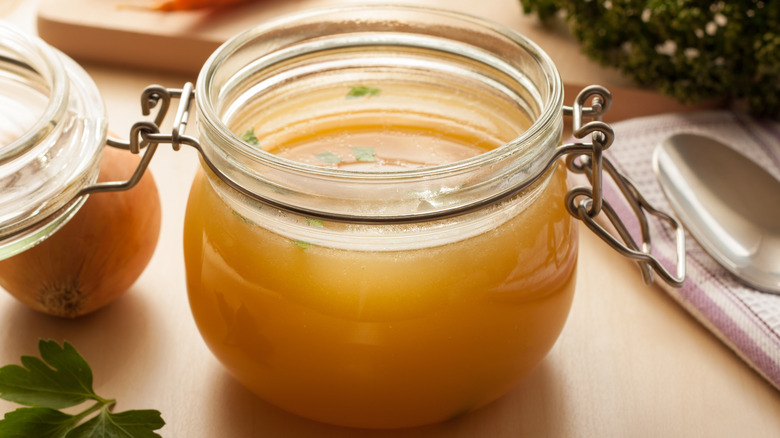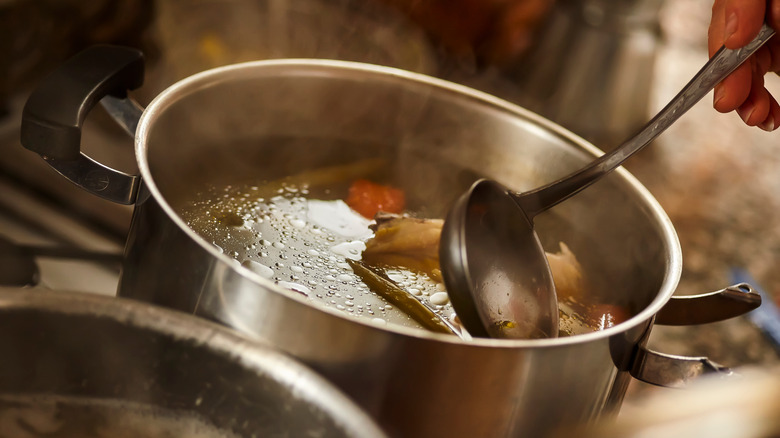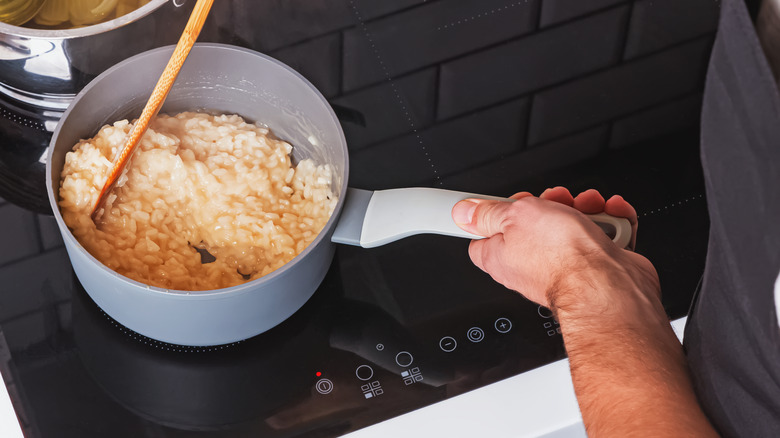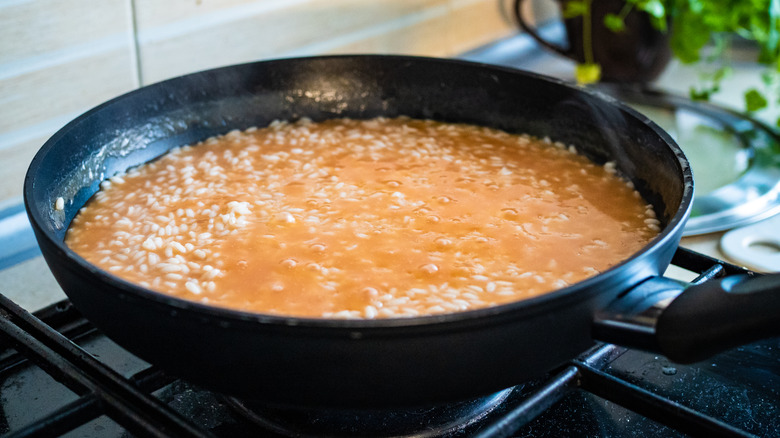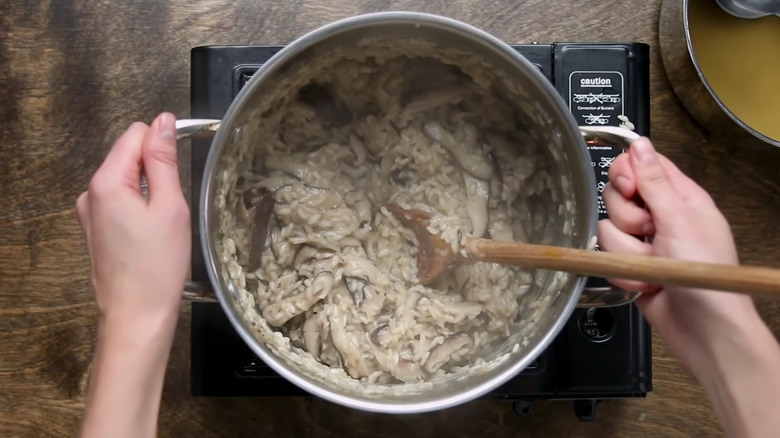9 Mistakes That Are Ruining Your Risotto
In its most basic form, risotto is a dish that is made from starchy, short-grained rice, cooked in stock until a rich and creamy texture is achieved. Invented in Milan, per Eataly, risotto has become popular across the world thanks to its luxurious nature and versatility. The latter is demonstrated by the wide range of accompanying ingredients used to flavor the dish, as noted by Cuisine at Home.
Thanks to these characteristics, this Italian staple is seen by many as the perfect evening meal. What's more, the dish is comforting, packed full of flavor, and deceptively quick to cook. However, there is one problem with risotto: Many home cooks find it an intimidating dish to create. This is for a few reasons, the most notable among them being that risotto is prone to both under and overcooking. A few minutes on either side of perfection can result in risottos with markedly different — and undesirable — textures (via NPR). Yet, it is not cooking time alone that has the potential to transform your luxurious risotto into something resembling lumpy porridge. In fact, there are numerous mistakes that have the potential to ruin this simple dish. The good news is all these mishaps can easily be avoided.
1. Rinsing the rice
A favorite tip of chefs the world over is to wash your rice. Normally, this is excellent advice. Rinsing your rice before cooking removes the excess starch that covers the grains during transit. The removal of this extra starch allows the rice to cook without clumping together, resulting in an enviably fluffy end product complete with distinct grains.
Be that as it may, risotto is one of the major exceptions to this rule thanks to the simple fact that you want as much starch in this dish as possible. Dan Souza, an American chef and food writer explained why to The Washington Post. "You want to avoid [rinsing] if you're making something like risotto or rice pudding," he said. "We found that rinsing compromises that desirable creamy consistency." It is important to note that this is the case no matter which rice variety you have chosen to use, as all will result in a better risotto when still dusted with excess starch.
2. Using bad alternatives to arborio rice
When it comes to making risotto, choosing the correct rice type is absolutely vital. In a nutshell, only short or medium grain rice can be used, as longer grains — such as basmati -– lack the starch necessary to create risotto's thick and creamy texture, per BBC Good Food. Fortunately, there are a number of specialist risotto rices that are perfectly suited for making the dish, including arborio, carnaroli, and roma.
The most popular of these is undoubtedly arborio thanks to it being sold in most major supermarkets (via Cuisine at Home). However, just because arborio is the most prevalent variety of risotto rice, does not mean it is best. In fact, many believe Carnaroli to be superior thanks to its incredibly high starch content, according to Broders' Cucina Italiana, while others prefer Vialone Nano for the slightly looser risotto it creates (via Los Angeles Times).
If specialist rice varieties are not available, we would still advise steering clear of long grain alternatives. Instead, other grains — such as pearl barley — can be used as a substitute for short grain rice. While lacking in starch, these grains will create a risotto with a fantastic bite and some unique flavors.
3. Toasting the rice for too long
An essential step in every risotto recipe is toasting the uncooked grains of rice. As this occurs just prior to the crux of risotto making — the adding of the stock — it can be a step that receives less attention from cooks. However, this stage — known as tostatura in Italian — should not be overlooked, as a misstep here will have dire consequences for your risotto.
In most culinary settings, toasting is used to enhance the flavor of ingredients. Rice is no different, and toasted rice has a noticeably deeper flavor profile when compared to its untoasted counterpart. In terms of risotto, this added dimension of flavor is extremely welcome, yet it is not the only reason behind this preliminary step. As La Cucina Italiana reports, toasting also ensures the risotto rice retains its structure during the cooking process.
The main mistake made during the tostatura is to over-toast the rice. The Guardian notes that if left to toast for too long, the rice grains will become unable to release their starch. Of course, this will determinately impact the texture of the finished product, ultimately resulting in a thin, unappetizing risotto. However, under-toasting also poses its own difficulties, namely the disintegration of rice during the cooking process. In order to avoid both these disasters be sure to toast your rice for a few minutes, until you can smell an almost nutty aroma, but no longer.
4. Browning the base vegetables
Browning ingredients, through a process known as the Maillard Reaction, is a gastronomic practice that results in the flavors, textures, and aromas humans most adore. As Modernist Cuisine reports, this process involves complex chemical changes occurring within ingredients, with molecules, such as amino acids, breaking down and reforming to create new compounds. Being the source of such incredible flavor, it seems illogical to advise against the browning of ingredients in any culinary setting. Yet, when making risotto, browning of base vegetables is to be avoided.
As noted by The Guardian, browning of base vegetables, such as onions, cannot be allowed to take place as it will impact the final flavor of the risotto to a great degree. Instead, base vegetables should be fried until soft, and in an onion's case, translucent. This will also ensure that your final risotto retains its light color and is not tinted an unappetizing brown by caramelizing onions. Any further ingredients you are looking to add to your risotto, for example, seafood, should always be cooked separately and added towards the end of the cooking process, per the Los Angeles Times.
5. Skimping on your stock
As the medium in which the entire dish is cooked, stock plays an enormously important role in the creation of risotto. Being immersed in the stock for a prolonged period — and absorbing it as the grains cook — means the flavor of your stock will be present throughout the dish from inside the rice itself to the creamy sauce. So, it should come as no surprise that stock choice impacts the final dish immensely. Due to their easy-to-use nature, many of us will employ commercially available stock cubes when cooking risotto. However, BBC Good Food reports that store-bought instant stocks cannot compete with the deep and complex flavors inherent in homemade stock.
The customizable nature of homemade stock means you can tailor make it to suit your planned risotto through the addition of herbs, such as rosemary. While there is no denying that making your own stock is a long process — simmering times tend to stand at about four hours — making vegetable stock is a much quicker option, taking about half this time, per MasterClass. These two hours or so will be time well spent, with the risotto achieving a depth and quality of flavor not replicable when using instant stock. As a happy aside, using homemade stock for your risotto will also make the dish a great deal healthier. As The Atlantic reports, a single stock cube can contain over the daily recommended intake of sodium and a startling amount of fats and oils.
6. Not keeping your stock hot
When it comes to adding your stock to the toasted risotto rice, there are many tips espoused by chefs and food writers alike. The most common of these is to add the stock slowly, one ladleful at a time. Another is to only add stock when the previous ladleful has been fully absorbed, as per The Guardian. A less frequently highlighted, but no less important, tip is that the stock being added should always be kept at a bare simmer, lest it reduce the overall temperature of the cooking risotto.
Speaking to Epicurious, Lidia Bastianich, an Italian-American chef, explained the importance of keeping your stock hot. "When the rice has absorbed all of the wine, and the kernel itself has flavor, you add the stock," she said. "It's important the stock is at the same temperature. You're trying to get those starches out and they're coming out, if you put cold stock you coagulate that. You're defeating your purpose of creaminess."
7. Stirring it the wrong way
Hand-in-hand with the addition of the stock comes risotto's other iconic process — stirring. This is the step most home cooks see as the crux of the cooking process, one riddled with potential mishaps. What doesn't help matters is the fact that there are two divergent schools of thought when it comes to stirring risotto.
The traditional method is to stir the rice near constantly using a girariso, a special type of spoon that emphasizes the impact of stirring (via The Guardian). However, more modern chefs, such as the Michelin starred Antonio Salvatore, disagree. He explained his process to Food & Wine. "Don't stress about constantly stirring risotto," he said. "It's much better to stir once every 30 seconds and trust the cooking process to do its thing."
We would advise Salvatore's method as occasional stirring allows the rice's starch to be fully released, a process that is vital for achieving the risotto's desired texture. Keep in mind that it's important not to go overboard. Too much stirring can cause a textural breakdown, as the agitation of the rice grains releases more starch, potentially leading to a gloopy final dish, per Southern Living. Under-stirring also poses its own risks, namely the risotto sticking to the bottom of the pan and burning. As such, it is advisable to stay near your bubbling risotto throughout the whole cooking process in order to keep an eye on it, stirring it every now and again.
8. Using the wrong cooking temperature
As with any dish, the temperature you cook your risotto at is incredibly important. Too cold and your risotto will be on the hob for far longer than the advised 20 minutes, destroying the dish's texture. Too hot and you greatly increase the risk of browning your vegetables, over toasting your rice, and ultimately burning your risotto. As reported by MasterClass, the heat level you are looking for translates into a gentle simmer, or, for the more scientifically minded, around 185 degrees Fahrenheit.
Knowing when to take your risotto off the heat is absolutely key, lest the dish becomes overcooked. NPR reports that the best way to test if the risotto is done is to bite into the rice. It should be firm, but, as BBC Good Food highlights, devoid of a white center. Once this has been achieved, the risotto should be immediately removed from the heat, covered, and allowed to rest for several minutes before the final stage, la mantecare, is performed, per Cento.
9. Skipping la mantecare
La mantecare, a method used in Italian cooking for both pasta and risotto, is a means of developing a creamy, uniform texture through the addition of fats, usually butter and cheese, per La Cucina Italiana. This stage is vital to the making of a good risotto, as the mixing of the starch and melted fats is what results in the thick, luxurious, and rich nature for which the dish is known. What's more, la mantecare gives the dish an added flavor boost as explained by Lidia Bastianich, once again. "If you add it at the last minute, the flavor is retained and it really kind of whips up. The same for the cheese," she notes (via Epicurious).
A vicious amount of stirring is necessary to ensure that the fat and starch blend sufficiently well, a fact highlighted by Felicity Cloake of The Guardian. So, be prepared to really whip the ingredients together. Once emulsified, the rice should be tipped onto hot plates to serve. If made correctly, the risotto should make this short journey in a wave-like motion. Now, all that's left to do is sit back, relax, and enjoy your perfectly executed risotto.
